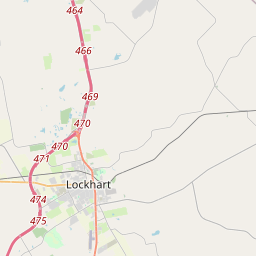Jeffrey Cemetery
Historical marker location:






Tennessee native Abraham Roberts wed Cynthia Jeffrey in Alabama in 1828. The couple arrived in Seguin, Texas, ten years later with their family. In 1840, Roberts purchased land on Tinney's Creek in what was then Gonzales County. He and other area residents petitioned the Texas Legislature to create a new county, which was formed in 1847 and named Caldwell. That year the Roberts family made the first burial on family property when granddaughter Martha Ellison died while visiting them. The family and local residents soon began using the site as a community burial ground.
There are conflicting stories about the origins of the cemetery name and about which family gave the land for the site, but a 1921 deed cited acreage conveyed earlier to a cemetery association. In 1938, the community officially adopted the name Jeffrey Cemetery and elected officers to a board of trustees.
Today, an association maintains the site and continues traditional homecomings for families and friends of those buried here. Among the several hundred graves are the names of veterans of military service dating to the U.S.-Mexican War, as well as generations of area residents.
Historic Texas Cemetery - 2004
As one of the most visible programs of the Texas Historical Commission (THC), historical markers commemorate diverse topics in Texas history, including: the history and architecture of houses, commercial and public buildings, religious congregations, and military sites; events that changed the course of local and state history; and individuals who have made lasting contributions to the state, community organizations, and businesses.
More history nearby
Texas is also home to the world's largest honky-tonk, Billy Bob's Texas in Fort Worth. The venue covers three acres and can hold up to 6,000 people.
In 1834, Mexican impresario, Green DeWitt, received a land grant from the Mexican government and began attracting American settlers to the area. The town of Lockhart, named after James W. Lockhart, one of DeWitt's surveyors, was established in 1838 and became the county seat in 1848. The county was officially organized the following year.
During the Civil War, Caldwell County, like much of Texas, was divided in its loyalties. Many residents sided with the Confederacy and fought in the war, while others were Union sympathizers. The conflict left deep scars on the county, but it managed to recover and thrive in the post-war years.
Throughout the late 19th and early 20th centuries, Caldwell County's economy was primarily agricultural, with cotton being a major crop. The arrival of the railroad in the late 1800s boosted economic growth and allowed for easier transportation of goods. Over time, the county diversified its economy, with industries such as oil and gas, cattle ranching, and manufacturing becoming prominent.
Today, Caldwell County is known for its historic charm, scenic beauty, and a strong sense of community. It is home to several notable landmarks, including the Caldwell County Courthouse, which is listed on the National Register of Historic Places. The county continues to evolve and adapt, while also preserving its rich history and heritage.
Caldwell County Timeline
This timeline provides a glimpse into the major events and milestones that have shaped the history of Caldwell County, Texas.
- 1848 - The Republic of Texas holds a land lottery and grants land in the area to settlers.
- 1849 - Caldwell County is officially established.
- 1852 - The county seat is named Lockhart.
- 1876 - The first courthouse in Lockhart is built.
- 1887 - The discovery of oil in the county brings prosperity.
- 1922 - The current Caldwell County Courthouse is constructed.
- 1948 - The Chisholm Trail Museum is established in Lockhart.
- 1984 - The Circuit of the Americas racetrack is built in the county.